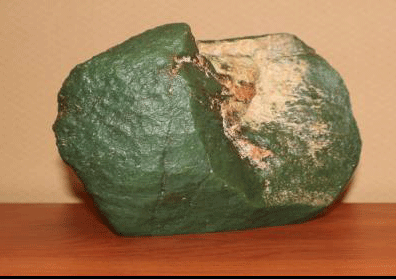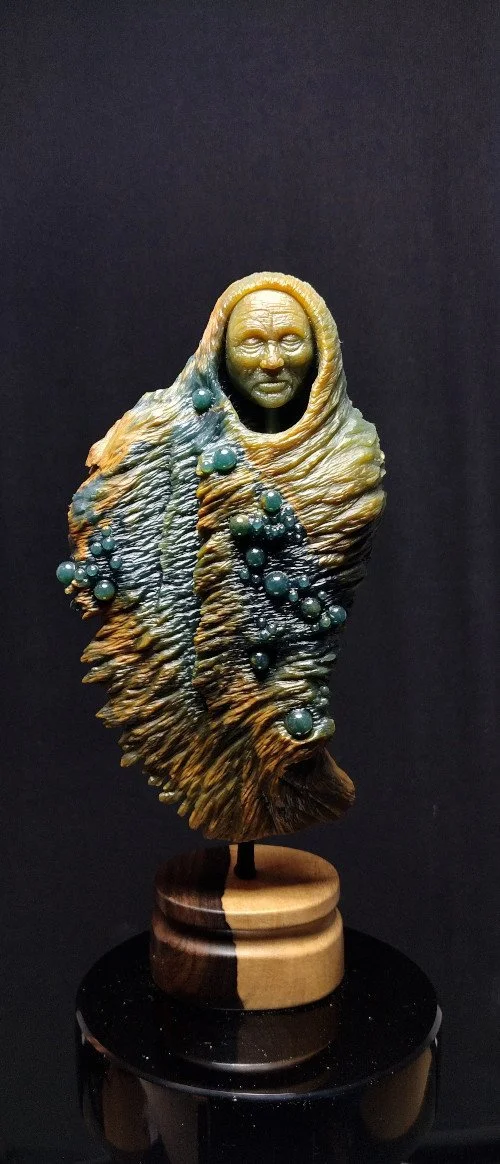Jade from the USA
There are quite a few deposits of nephrite jade in the USA. The best is in Wyoming. There are different stories about when and how jade was found in Wyoming. There is some evidence that it was Chinese workers building a rail road through the state who first came across it in the second half of the nineteenth century. Americans first noticed it near Jefferson City in the 1930’s. It wasn’t long before a “jade rush” began. Trucks were needed to carry away some of the heaviest boulders. The jade fields have now been picked almost clean but intrepid jade hunters still find some very nice stones and in recent years miners using more sophisticated equipment than was available even a few years ago are finding significant deposits. The apple and emerald green jade is some of the best in the world and fetches extremely high prices. The best black nephrite and olive nephrites also come from this area.
Jade from the Americas
A lot of fine jade comes from north and central America. Much of it now goes to satisfy the seemingly insatiable Chinese market.
Small cobble of emerald green nephrite jade from Wyoming.
Nephrite jade is also the state gem of Alaska which has large deposits including an entire mountain of jade on the Seward Peninsula. Large deposits have also been found in Washington State. The quality of the jade from these two states does not come anywhere close to that of the best nephrite found in Wyoming.
Big Sur in California. Home of the Big Sur Jade Festival
California is rich in jade. Jade Cove in Big Sur is one of the places where you can pick up jade pebbles on the beach. Small coves nearby are also good hunting grounds. There are substantial deposits dotted around the state. Californian jade is not of the highest quality but a small jade culture has built up around it with annual festivals in Big Sur and Monterey. There are also large amounts of nephrite in Washington State. The quality of this stone varies but efforts are now being made to market it.
Canadian Jade
Canada has huge amounts of green nephrite and hundreds of tons a year are now exported to China. While this export industry is a recent phenomenon it is believed that jade was discovered in Canada by Chinese labourers working on a a rail-road through Fraser Canyon in British Colombia in the late nineteenth century. It is said they smuggled it back to China in the coffins of workers killed while building the rail-road. None of this can be proved but experienced miners in the modern Canadian jade industry say that old nephrite pieces recorded in China long before exports officially took off look remarkably like Canadian jade. China now imports more nephrite from Canada than any other country in the world.
Guatemalan Jadeite
Jade has been carved in Central America for thousands of years. The Olmecs, Mayans and Aztecs all treasured jade far more than gold. the Aztecs considered gold no more than the sweat of the sun. Like the Chinese and Maori in New Zealand they attributed great spiritual significance to jade. When Henan Cortez and his conquistadores plundered the Aztec empire they had no interest in the stone of heaven. All they wanted was gold. When the Aztec emperor, Montezuma, offered Henan Cortez two perfect beads of the stone of heaven and told him they were worth each worth wagon loads of gold he showed no interest
The conquistadores destroyed the Aztec empire. Millions of the native inhabitants were either killed or died from diseases imported from Europe which they had no resistance to. The collapse of the Aztec civilization was so complete that the art of jade carving was forgotten. Even the location of the mines where the stone was found was lost to memory. It took a couple from the United States, Jay and Mary Lou Ridinger to rediscover jade. They found it in Guatemala and reintroduced the art of jade carving. It kickstarted a jade carving industry which is now beginning to thrive throughout Central America. There are now talented artists working with jade throughout the region.
Lord of the Wind by Adan Bernabé Pilicastro Alcázar. One of the many talented artists now making a living carving jade in Central America.





